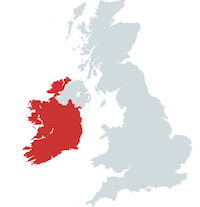
Map by mapchart.net - Some rights reserved.
Location
Trim, County Meath, Ireland
Description
Trim Castle is situated in the centre of Trim town on the shores of the River Boyne.
The remains of the castle are not only those of Ireland's largest castle but the largest Norman castle in Europe.
The castle consists of a central 3 story cruciform shaped keep with twenty corners, the remains of a curtain wall which has rectangular towers on the north and west sides and round towers to the south and east, the remains of a three towered defending keep entrance with stables and causeway, a three aisled Great Hall with undercroft, a defensive tower and a building thought to have been used as a mint.
Facilities
Access to the castles' keep is by guided tour only; the rest of the site can be visited alone.
The castle is open to the public between Easter and the 30th September 10am to 6pm, during October 9.30am to 17.30 and during the winter at weekends only between 9.30am and 5pm. Some of the outlying parts of the castle can be visited all year round including a small restored canal which is accessible over a pedestrian river bridge.
Overlooking the castle and St Patrick's Church is the Trim Castle Hotel. The contemporary hotel offers 68 luxurious rooms and all the other facilities that a modern hotel should offer including the Barista Cafe, Jules Restaurant and the Bailey Bar. The hotel is also a popular venue for wedding receptions with floor to ceiling windows overlooking the castle and a third floor decked terrace for extra special photographs. The hotel's wedding coordinator can help with all the fine details and with a one wedding a day policy and a maximum guest capacity of 350 people the hotel staff are guaranteed to be attentive.
History
The castle was built on a very important site with access to the Irish Sea 25 miles away by boat up the river Boyne. It was used as the administration centre for the Normans and was given to Hugh de Lacy in 1172.
Hugh and his son Walter were responsible for building the castle's ring work defences and external ditch which continued until 1204. During the second half of the 13th century the castle was owned by Geoffrey de Geneville who was responsible for building two wooden towers, the Great Hall, drawbridge and the north tower. In the early 14th century the castle passed through marriage into the Mortimer family, it was left abandoned in 1425 after the death of the last family member.
At the beginning of the 15th century King Richard II granted occupancy to two of his wards, one of them being the future King Henry V. During the 16th and 17th centuries the castle lost its importance; other than as a military site for Cromwell's soldiers, and was allowed to fall into disrepair when the army left in 1649.
At the end of the Cromwellian wars the site was granted to the Wellington family and after them though several other families until it was given by the court to the Dunsany Plunketts. The family allowed the lands to be rented out; even letting the local town council dump waste there, but after many years Lord Dunsany eventually sold the castle and lands to the state.
The Office of Public Works then became responsible for the castle and started a major restoration project including the installing a protective roof and partly restoring the moat.
The Arts
The castle was used for filming of the film 'Braveheart' directed and staring Mel Gibson in 1995.
Other Castles in the Area
Ardbraccan House, County Meath
Athcarne Castle, County Meath
Barberstown Castle, County Kildare
Bective Abbey, County Meath
Bellinter House, County Meath
Carbury Castle, County Kildare
Castletown House, County Kildare
Dunsany Castle, County Meath
Liscarton Castle, County Meath
Maynooth Castle, County Kildare
Monktown Castle, County Meath
Slane Castle, County Meath
Tully's Castle, County Dublin
|
|
|
|

